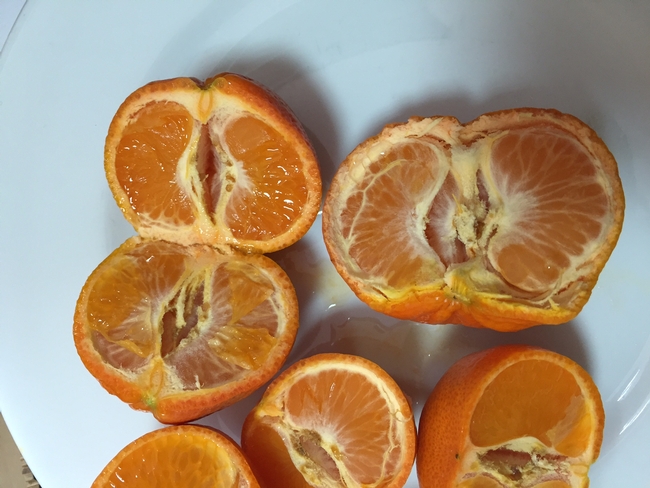Recently some 'W. Murcott' mandarins were shown to me. Brown spots in the core of the fruit. Another problem caused by drought and lack of leaching rains? Endoxerosis, also called internal decline, dry core, yellow tip, dry and blossom end decline is often confused with Alternaria rot which frequently accompanies or follows it. Internal tissues back of the stylar end break down, dry and become pinkish or brownish in color. Gum commonly forms in the core and either in or nest to the rind. Green fruits lose luster and frequently but not always develop a yellow color in circular areas surround the stylar end. The cut fru9i shows the gummy pinkish to brownish mass of partially dried and collapsed tissue. Gumming may even extend into the twig bearing the affected fruit. When the fruit turns color, the malady is more difficult to detect without cutting.
The cause is believed to be related to water and the physiological conditions within the tree and fruit and temperature conditions in the air and soil influencing transpiration and water stress. It is suggested therefore that water conditions in the soil be kept as favorable for tree heath as possible and pick on time so that they are not over mature.
From: The Citrus Industry, Volume IV, Editor: Walter Reuther, UC Press
In other words, make sure to leach the root zone of accumulated salts from previous irrigations and pray for rain.
Craig Kallsen in Kern County says he often sees this in young mandarins especially on the south and west sides of the canopy, to the point that growers will not even bother to harvest this fruit until the trees are older. The fruit just transpires so much water when it's not shaded that the fruit just dries out.
If my Latin serves me right: endo - inside, xeric - dry. Dry Inside.
Attached Images:
